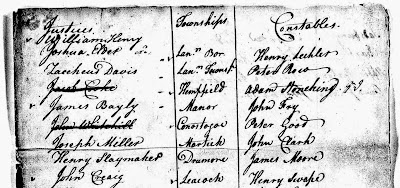52 Ancestors II, Week 54: James Bayly
 |
| Justice James Bayly |
James Bayly, born about 1730, was one of four children born to Thomas and Mary Bayly, who “was the first to settle on the in Donegal township, (Lancaster County) PA in 1718, the land was warranted to Thomas soon afterwards, though it was not patented during his lifetime. Thomas' widow Mary eventually received the patent on 8 Aug 1743, for 279 acres, which she conveyed to her sons (James and John) in 1749.” (1)
Thomas, died in 1734, when James was only 4, and Mary died in 1749 when James was 19.
James Bayly must have sold his portion of his inherited land to his brother John, because he "resided upon and owned the farm adjoining 'Duffy's Park' on the north, which he purchased 7 Aug 1767. James was a justice of the peace, and of the Court of Common Pleas, during the Revolution, before whom the oath of allegiance was taken by the citizens of Donegal and vicinity."(2)
James Bayly served in “the 3rd Pennsylvania Regiment, first known as the 2nd Pennsylvania Battalion. It was raised on December 9, 1775, at Philadelphia, Pennsylvania for service with the Continental Army. The regiment would see action during the Battle of Valcour Island, Battle of Brandywine, Battle of Germantown, Battle of Monmouth and the Battle of Springfield. The regiment was furloughed, on June 11, 1783, at Philadelphia, Pennsylvania and disbanded on November 15, 1783.” (3)
"James was a "wagonmaster," an important position in that trying period.” (2)
“During the campaign of 1776, congress created a Wagon Department that had full responsibility for overland transportation. The organization consisted of a wagon master general and a wagon master for each department. It was the beginning of the Army's first "Transportation Corps." (4)
 |
| Conestoga Wagon http://www.transchool.lee.army.mil/museum/ transportation museum/revolutionary.htm |
"The army used the Conestoga Wagon, named for the Conestoga Valley in Lancaster County, Pennsylvania. It was first used in the 1750s to transport produce to Philadelphia. The distinctive curved cargo bed of the Conestoga was designed to keep cargo from shifting. An excellent design, it was used throughout the country for the next 100 years.” (4)
"James married, the second time, Mary Cook, widow. The names of the children of James and Mary Bayly are from his will, dated 1 Oct 1793, probated 27 Nov 1793:
- John (our ancestor), to whom he gave the homestead farm; and
- Thomas, who got the land adjoining Maytown;
- daughter Margaret,
- stepdaughter Margaret Cook,
- son-in-law Richard Keys (wife Mary Bayly) and son-in-law Stephen Stevenson (wife Ruth Bayly) are mentioned as legatees. Stephen Stephenson was an officer in the army that went to the western part of the State to quell the Whiskey Insurrection.” (5)
Sources:
- Excerpted from A History of Lancaster County by H.M.J. Klein, Ph.d., 1926
- History of Lancaster County, Pennsylvania, with Biographical Sketches of Many of its Pioneers and Prominent Men Chapter XLVII. East Donegal Township.<1<[1 By Samuel Evans, Esq.]
- http://en.wikipedia.org/wiki/3rd_Pennsylvania_Regiment
- http://www.transchool.lee.army.mil/museum/transportation%20museum/revolutionary.htm
- Authentic History of Donegal Presbyterian Church, located in East Donegal Township, Lancaster Co., Pa. (page 6 of 13)
- PA Archives, 2nd Series, Vol XIII, page 472;
- History of Lancaster County, PA (1883) by Ellis and Evans, pp 763, 764












Shannon, it's very interesting to me that Thomas Bayly and his son James Bayly and their descendants have the last name that was to eventually be your grandpa Bayly's first name many generations later. Grandpa Bayly certainly had a lot of ancestors that did their part in the Continental Army fighting for this nations freedom and independence.
ReplyDelete